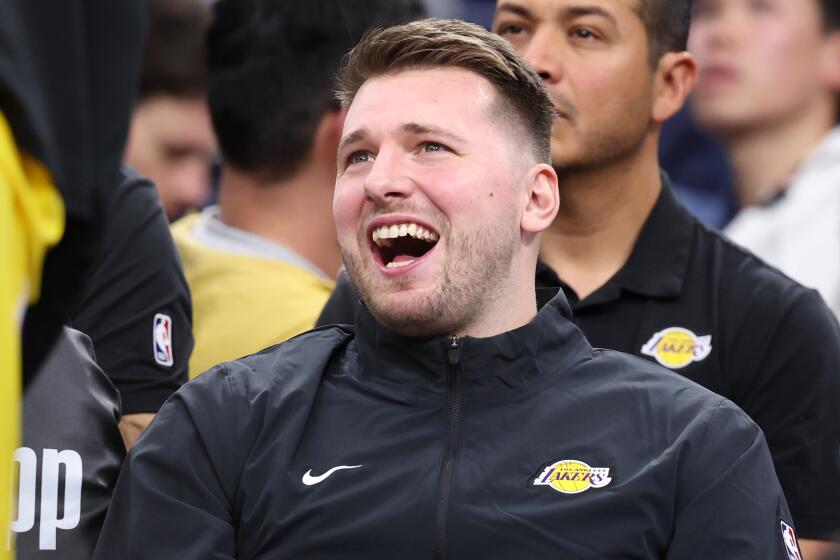College Basketball Coaches Use Videotapes to Scout the Opposition
- Share via
CHICAGO — It was late on a Sunday evening in Digger Phelps’ crowded office. The Notre Dame coach and his staff were scurrying to locate some videotapes.
No, they weren’t looking for a copy of “Aliens” or “Jane Fonda’s Workout.” The Irish had received word they were in the NCAA field of 64 as expected but they knew very little about their opening-round opponent--Middle Tennessee State--and were making calls around the country to see if anyone had videos on their opponent.
The NCAA tournament has grown into the modern era of video technology. Where in the past, schools relied on personal scouting reports or word of mouth from other coaches, videotapes have become as commonplace as the chalkboard in the locker room.
“When it becomes tough is when you can’t find one, like we had in our opening game,” Phelps says. “Our second-round opponent, TCU, had played on television so it was easy to get them. On Middle Tennessee State, we had to call someone who gets these tapes and sells them at the end of the year.”
The explosion of cable television and college basketball occurred at about the same time. As a result, there are more teams on television and more opportunities for the games to be taped.
First- and second-round upsets are determined on the court. But Phelps did concede not knowing much about an early-round opponent and the inability to secure tape on the teams is a contributing factor.
“Sure, that’s part of it. It’s hard to prepare for a team when you don’t have the videotapes,” Phelps says. “And it’s doubly difficult when that team has a whole library of tapes about you.”
Said DePaul Coach Joey Meyer, “It can also work against you. There is no hiding anymore. We had so many of our games on TV that it was easy for an opposing coach to come in and know what we’ve done because he’s taped our games.”
The size of the athletic budget also has an impact of how much money is spent locating videotapes and building up a team library.
Southern U. Coach Frank Jobe was aware of his team’s first-round opponent, Temple, but had not seen them on tape or film. Southern’s athletic budget is not in the same league as Notre Dame’s budget.
“We hadn’t ever seen them play. Didn’t know anything about them,” Jobe said.
But in the same vein, Temple Coach John Chaney had never seen Southern play on TV or on tape.
“It is different, playing a team which you’ve seen on tape and can prepare for,” Chaney said. “That is why the NCAA tournament is so competitive and that is why you see some of the things happen that you see.”
In the 1970s, appearing on national television not only got your program exposure, it also allowed opponents to get an idea of the style of play your team advocated.
But that was before widespread use of videotape recorders. And it was also before regional cable outlets made college basketball the cornerstone of their pitch to subscribers.
Nearly every major conference has a cable package with some regional or national outlet. As a result, it is easy for Phelps to pick up the phone and get as many tapes that he wants of a North Carolina or Georgetown. It isn’t as easy when schools from some of the so-called “minor” conferences.
Many of the smaller leagues that have automatic bids but don’t have extensive television exposure still play in relative obscurity. Leagues like the AMCU-8, which spawned Cleveland State last year and Southwest Missouri State this year, seldom appear on TV. Others like the Ohio Valley Conference or Midwestern City, which this year produced upset winners in Austin Peay and Xavier, have limited exposure.
“Preparing for an NCAA tournament game involves a lot of things, but when we had to play St. John’s, it was easy to get tapes of them and see what they did. It was also to prepare because they were on TV seemingly every week,” said Wichita State Coach Eddie Fogler. “Heck, schools like the ones in the Big Ten and Big East are on TV all the time. You can do your own scouting just by watching the games.”
When they aren’t looking for videotapes, coaches now find themselves glued in front of the TV watching as many games as they can.
“I watched a game right after ours last week,” Phelps says. “That’s part of it now.”
Purdue Coach Gene Keady admits to staying up on Monday nights during the season to watch games on cable, particularly the Big Ten package. When he can’t watch the games, he tapes them.
“You want to see as much as you can,” Keady says. “Nowadays, you can get a much better idea of what a club is doing because of the widespread exposure.”
Unless you are playing a Middle Tennessee State. Then, it’s a matter of late night phone calls and searching for anyone with a videotape.
Notre Dame must have found something. The Irish avoided the upset and defeated their first-round opponent.
More to Read
Go beyond the scoreboard
Get the latest on L.A.'s teams in the daily Sports Report newsletter.
You may occasionally receive promotional content from the Los Angeles Times.










